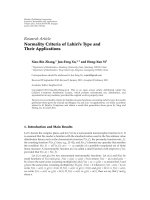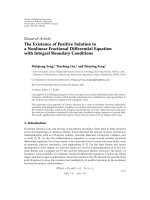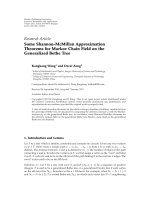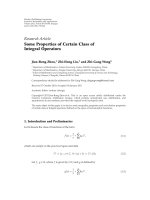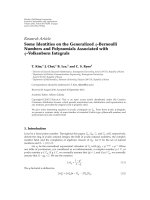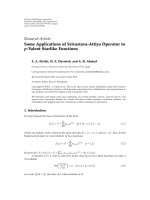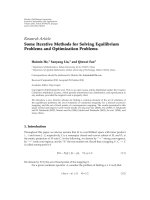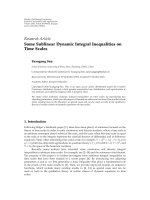Báo cáo hóa học: " Research Article Some Applications of Srivastava-Attiya Operator to p-Valent Starlike Functions" pot
Bạn đang xem bản rút gọn của tài liệu. Xem và tải ngay bản đầy đủ của tài liệu tại đây (494.72 KB, 11 trang )
Hindawi Publishing Corporation
Journal of Inequalities and Applications
Volume 2010, Article ID 790730, 11 pages
doi:10.1155/2010/790730
Research Article
Some Applications of Srivastava-Attiya Operator to
p-Valent Starlike Functions
E. A. Elrifai, H. E. Darwish, and A. R. Ahmed
Faculty of Science, Mansoura University, Mansoura 35516, Egypt
Correspondence should be addressed to H. E. Darwish,
Received 25 March 2010; Accepted 14 July 2010
Academic Editor: Ram N. Mohapatra
Copyright q 2010 E. A. Elrifai et al. This is an open access article distributed under the Creative
Commons Attribution License, which permits unrestricted use, distribution, and reproduction in
any medium, provided the original work is properly cited.
We introduce and study some new subclasses of p-valent starlike, convex, close-to-convex, and
quasi-convex functions defined by certain Srivastava-Attiya operator. Inclusion relations are
established, and integral operator of functions in these subclasses is discussed.
1. Introduction
Let A p denote the class of functions of the form
f z
∞
zp
an p zn
p
p∈N
{1, 2, 3, . . .} ,
1.1
n 1
{z : z ∈ C and |z| < 1}. Also, let the
which are analytic and p-valent in the open unit disc U
Hadamard product or convolution of two functions
fj z
zp
∞
an
n p
p,j z
j
1, 2
1.2
n 1
∞
n p
zp
f2 ∗ f1 z .
be given by f1 ∗ f2 z
n 1 an p,1 an p,2 z
A function f z ∈ A p is said to be in the class S∗ α of p-valent functions of order α
p
if it satisfies
Re
we write S∗ 0
p
zf z
f z
>α
0 ≤ α < p, z ∈ U .
S∗ , the class of p-valent starlike in U.
p
1.3
2
Journal of Inequalities and Applications
A function f ∈ A p is said to be in the class Cp α of p-valent convex functions of
order α if it satisfies
zf z
f z
Re 1
0 ≤ α < p, z ∈ U .
>α
The class of p-valent convex functions in U is denoted by Cp
It follows from 1.3 and 1.4 that
f z ∈ Cp α iff
zf z
∈ S∗ α
p
p
1.4
Cp 0 .
0≤α
1.5
The classes S∗ and Cp were introduced by Goodman 1 . Furthermore, a function
p
f z ∈ A p is said to be p-valent close-to-convex of order β and type γ in U if there exists a
function g z ∈ S∗ γ such that
p
Re
zf z
g z
0 ≤ β, γ < p, z ∈ U .
>β
1.6
We denote this class by Kp β, γ The class Kp β, γ was studied by Aouf 2 . We note
K β, γ was studied by Libera 3 .
that K1 β, γ
A function f ∈ A p is called quasi-convex of order β type γ, if there exists a function
g z ∈ Cp γ such that
Re
zf z
g z
z ∈ U,
> β,
1.7
∗
∗
where 0 ≤ β, γ < p. We denote this class by Kp β, γ . Clearly f z ∈ Kp β, γ ⇔ zf z /p ∈
Kp β, γ .The generalized Srivastava-Attiya operator Js,b f z : A p → A p in 4 is
introduced by
Js,b f z
Gs,b z ∗ f z
z ∈ U : b ∈ C \ Z0
{0, −1, −2, −3, . . .}, s ∈ C, p ∈ N
1.8
where
Gs,b z
φ z, s, b
1
b
s
φ z, s, b − b−s ,
zp
1 b
1
bs
z1 p
2 b
s
s
··· .
1.9
It is not difficult to see from 1.8 and 1.9 that
Js,b f z
zp
∞
n 1
1
n
s
b
1
b
an p zn p .
1.10
Journal of Inequalities and Applications
3
When p 1, the operator Js,b is well-known Srivastava-Attiya operator 5 .
Using the operator Js,b , we now introduce the following classes:
S∗
p,s,b γ
f z ∈ A p : Js,b f z ∈ S∗ γ
p
,
Cp,s,b γ
f z ∈ A p : Js,b f z ∈ Cp γ
,
1.11
Kp,s,b β, γ
f z ∈ A p : Js,b f z ∈ Kp β, γ
,
∗
Kp,s,b β, γ
∗
f z ∈ A p : Js,b f z ∈ Kp β, γ
.
In this paper, we will establish inclusion relation for these classes and investigate SrivastavaAttiya operator for these classes.
We note that
1 for s
σ, b
p, we get Jung-Kim-Srivastava
2 for s
1, 1
b
c
6, 7 ;
p, we get the generalized Libera integral operator. 8, 9 ;
3 for s −k being any negative integer, b
was studied by S˘ l˘ gean 10 .
aa
0, and p
1, the operator J−k,0
Dk f z
2. Inclusion Relation
In order to prove our main results, we will require the following lemmas.
Lemma 2.1 see 11 . Let w z be regular in U with w 0
on the circle |z| r at a given point z0 ∈ U, then z0 w z0
k ≥ 1.
0. If |w z | attains its maximum value
kw z0 , where k is a real number and
v1 iv2 , and let ψ u, v be a complex function,
Lemma 2.2 see 12 . Let u
u1 iu2 , v
ψ : D → C, D ⊂ C × C. Suppose that ψ satisfies the following conditions:
i ψ u, v is continuous in D,
ii
1, 0 ∈ D and Re{ψ 1, 0 } > 0,
iii Re{ψ iu2 , v1 } ≤ 0 for al iu2 , v1 ∈ D such that v1 ≤ − 1
u2 /2.
2
Let h z
1 c1 z c1 z2 · · · be analytic in U, such that h z , zh z
Re{ψ h z , zh z } > 0, z ∈ U then Re h z > 0 for z ∈ U.
∈ D for z ∈ U. If
Our first inclusion theorem is stated as follows.
Theorem 2.3. S∗
γ ⊂ S∗
p,s.b
p,s
1,b
γ for any complex number s.
Proof. Let f z ∈ S∗
γ , and set
p,s,b
z Js 1,b f z
Js 1,b f z
−γ
p−γ h z ,
2.1
4
where h z
Journal of Inequalities and Applications
1
c1 z
z Js
· · · . Using the identity
c2 z2
1,b f
p− 1
z
b
Js
1,b f
z
1
b Js,b f z ,
2.2
we have
Js,b f z
Js 1,b f z
z Js 1,b f z
Js 1,b f z
1
1
Js,b f z
Js 1,b f z
b
1
b
1
−p
b
2.3
p−γ h z −p
γ
1 ,
b
1 .
Differentiating 2.3 , logarithmically with respect to z, we obtain
z Js,b f z
Js,b f z
−γ
p − γ zh z
p−γ h z
Now, from the function ψ u, v , by taking u
h z, v
γ −p
p−γ u
b
1
.
2.4
zh z in 2.4 as
p−γ v
p−γ u
ψ u, v
p−γ h z
γ −p
b
1
,
2.5
it is easy to see that the function ψ u, v satisfies condition i and ii of Lemma 2.2, in D
C − { γ − p b 1 / γ − p } × C. To verify condition iii , we calculate as follows:
Re ψ iu2 , v1
Re
Re
Re
p − γ v1
p − γ iu2
p − γ v1 γ − p
p−γ
p−γ
γ −p
p−γ
γ −p
p−γ
1−p
b
γ
2
2
1−p
b
γ
2
2.6
1 v1
b
γ −p
b
2
1−p
2 p − γ u2
2
1 − i p − γ u2
1 v1 − i p − γ v1 u2
b
b
1
1−p
2
2 2
u2
b
b
2 2
u2
p − γ u2
2
p−γ
≤−
γ −p
γ
1 1
b
2
u2
2
γ
2
< 0,
where v1 ≤ − 1 u2 /2 and iu2 , v1 ∈ D. Therefore, the function ψ u, v satisfies the
2
conditions of Lemma 2.2.
This shows that if Re h z , zh z > 0 z ∈ U , then
Re h z
> 0,
z∈U .
2.7
Journal of Inequalities and Applications
5
if f ∈ S∗ γ , then
s
∗
S∗
p,s,b γ ⊂ Sp,s
1,b
γ .
2.8
This completes the proof of Theorem 2.3.
Theorem 2.4. Cp,s,b γ ⊂ Cp,s
γ , for any complex number s.
1,b
Proof. Consider the following:
z
Js,b f z
p
f z ∈ Cp,s,b γ ⇐⇒ Js,b f z ∈ Cp γ ⇐⇒
zf z
p
⇐⇒ Js,b
∈ S∗ γ ⇐⇒
p
zf z
∈ S∗
p,s
p
⇒
⇐⇒
z
Js
p
1,b f
1,b
zf z
∈ S∗
p,s,b γ
p
1,b
∈ S∗ γ ⇐⇒ Js
p
z
⇐⇒ f z ∈ Cp,s
γ ⇐⇒ Js
1,b
∈ S∗ γ
p
zf z
p
1,b f
2.9
∈ S∗ γ
p
z ∈ Cp γ
γ ,
which evidently proves Theorem 2.4.
Theorem 2.5. Kp,s,b β, γ ⊂ Kp,s
β, γ , for any complex number s.
1,b
Proof. Let f z ∈ Kp,s,b β, γ . Then, there exists a function k z ∈ Sp γ such that
Re
z Js,b f z
g z
z∈U .
>β
2.10
Taking the function k z which satisfies Js,b k z
g z , we have k z ∈ Sp γ and
Re{z Js,b f z /Js,b k z } > β z ∈ U .
p − β h z , where h z
1 c1 z c2 z2 · · · .
Now, put z Js 1,b f z / Js 1,b k z − β
Using the identity 2.2 we have
z Js,b f z
Js,b k z
Js,b zf z
Js,b k z
z Js
1,b
z Js
z Js
1,b
z
− p− 1
b Js
1,b
1,b k z
− p− 1
b Js
1,b k z
zf
zf
z
/Js
z Js
1,b k
1,b k
z
zf
z − p− 1
/Js
1,b k
z
b Js
2.11
1,b
z − p− 1
zf
b
z /Js
1,b k
z
.
6
Journal of Inequalities and Applications
γ and S∗
γ ⊂ S∗ 1,b γ , we let z Js 1,b k z
Since k z ∈ S∗
p,s,b
p,s,b
p,s
γ, where Re H z > 0 z ∈ U thus 2.11 can be written as
z Js,b f z
Js,b k z
z Js
1,b
zf
/Js
z
1,b k
z − p− 1
p−γ H z
/Js
b
γ − p− 1
1,b k
p−γ H z
z
p−β h z
β
.
b
2.12
Consider that
1,b f
z Js
z
Js
1,b k
p−β h z .
z β
2.13
Differentiating both sides of 2.13 , and multiplying by z, we have
z Js 1,b zf z
Js 1,b k z
p − β zh z
p−β h z
β
·
p−γ H z
γ .
2.14
.
2.15
Using 2.14 and 2.12 , we get
z Js,b f z
Js,b k z
Taking u
h z ,v
−β
p − β zh z
p−β h z
p−γ H z
γ − p− 1
b
zh z in 2.15 , we form the function ψ u, v as
ψ u, v
p−β u
p−β v
p−γ H z
γ − p− 1
b
.
2.16
It is not difficult to see that ψ u, v satisfies the conditions i and ii of Lemma 2.2 in D
C × C. To verify condition iii , we proceed as follows:
p − β v1 p − γ h1 x, y
Re ψ iu2 , v1
p − γ h1 x, y
γ
1
b −p
γ − p− 1
2
b
p − γ h2 x, y
2
,
2.17
where H z
h1 x, y
ih2 x, y , h1 x, y and h2 x, y being the functions of x and y and
Re H z
h1 x, y > 0.
By putting v1 ≤ − 1/2 1 u2 , we have
2
Re ψ iu2 , v1 ≤ −
p−β 1
2
u2
2
p − γ h1 x, y
p − γ h1 x, y
γ
Hence, Re h z > 0 z ∈ U and f z ∈ Kp,s
∗
∗
Theorem 2.6. Kp,s,b β, γ ⊂ Kp,s
1,b
1
1,b
b −p
γ − p− 1
2
b
p − γ h2 x, y
2
< 0.
2.18
β, γ . The proof of Theorem 2.5 is complete.
β, γ for any complex number s.
Journal of Inequalities and Applications
7
Proof. Consider the following:
∗
∗
f z ∈ Kp,s,b β, γ ⇐⇒ Js,b f z ∈ Kp β, γ
⇐⇒
z
Js,b f z
p
⇐⇒ Js,b
∈ Kp β, γ
zf z
p
∈ Kp β, γ
zf z
∈ Kp,s
⇒
p
⇐⇒
z
Js
p
⇐⇒ Js
1,b f
1,b f
1,b
⇒
β, γ ⇐⇒ Js
zf z
∈ Kp,s,b β, γ
p
zf z
p
1,b
2.19
∈ Kp β, γ
∈ Kp β, γ
z
∗
z ∈ Kp β, γ
∗
⇒ f z ∈ Kp,s
1,b
β, γ .
The proof of Theorem 2.6 is complete.
3. Integral Operator
For c > −1 and f z ∈ A p , we recall here the generalized Bernardi-Libera-Livingston
integral operator Lc f z as follows
pz
c
Lc f z
zc
p
0
tc−1 f t dt
∞
c
z
c
n 1
c
3.1
p
p
n p
n
an p z
.
The operator Lc f z when c ∈ N
{1, 2, 3, . . .} was studied by Bernardi 13 , for
1, L1 f z was investigated earlier by Libera 14 . Now, we have
Js,b Lc f z
zp
∞
n 1
1
1
s
b
b
n
c
c
p
p
n
an p zn p ,
3.2
so we get the identity
z Js,b Lc f z
c
p Js,b f z − c Lc f z .
3.3
The following theorems deal with the generalized Bernard-Libera-Livingston integral
operator Lc f z defined by 3.1 .
Theorem 3.1. Let c > −γ, 0 ≤ γ < p. If f z ∈ S∗
γ , then Lc f z ∈ S∗
γ .
p,s,b
p,s,b
8
Journal of Inequalities and Applications
Proof. From 3.3 , we have
z Js,b Lc f z
Js,b Lc f z
p Js,b f z
c
Js,b Lc f z
where w z is analytic in U, w 0
−c
1 − 2γ ω z
,
1−ω z
1
3.4
0. Using 3.3 and 3.4 we get
c
Js,b f z
Js,b Lc f z
w z 1 − c − 2γ ω z
p
.
p 1−ω z
c
3.5
Differentiating 3.5 , we obtain
1 − 2γ w z
zw z
−
1−w z
1−w z
1
z Js,b f z
Js,b f z
1 − c − 2γ zw z
p
c
1 − c − 2γ w z
.
3.6
Now we assume that |w z | < 1 z ∈ U . Otherwise, there exists a point z0 ∈ U such that
kw z0 , k ≥ 1. Putting
max |w z | |w z0 | 1. Then by Lemma 2.1, we have z0 w z0
eiθ in 3.6 , we have
z z0 and w z0
Re
z0 Js,b f z0
Js,b f z0
−γ
Re
2 1 − γ keiθ
1 − eiθ
p
c
1 − c − 2γ eiθ
−2k 1 − γ
1
c
2
21
c
3.7
γ
c 1 − c − 2γ cos θ
1 − c − 2γ
2
≤ 0,
which contradicts the hypothesis that f z ∈ S∗
γ .
p,s,b
Hence, |w z | < 1, for z ∈ U, and it follows 3.4 that Lc f ∈ S∗
γ .
p,s,b
The proof of Theorem 3.1 is complete·
Theorem 3.2. Let c > −γ, 0 ≤ γ < p. If f ∈ Cp,s,b γ , then Lc f z ∈ Cp,s,b γ .
Proof. Consider the following:
f z ∈ Cp,s,b γ ⇐⇒
zf z
∈ S∗
p,s,b γ
p
⇒ Lc
zf z
p
∈ S∗
p,s,b γ ⇐⇒
z
Lc f z
p
∈ S∗
p,s,b γ
⇐⇒ Lc f z ∈ Cp,s,b γ .
This completes the proof of Theorem 3.2.
Theorem 3.3. Let c > −γ, 0 ≤ γ < p.If f z ∈ Kp,s,b β, γ then Lc f z
∈ Kp,s,b β, γ .
3.8
Journal of Inequalities and Applications
9
γ such
Proof. Let f z ∈ Kp,s,b β, γ . Then, by definition, there exists a function g z ∈ S∗
p,s,b
that
z Js,b f z
Js,b g z
Re
z∈U .
>β
3.9
Then,
z Js,b Lc f z
Js,b Lc g z
where h z
c1 z
c2 z2
p−β h z
3.10
· · · . From 3.3 and 3.10 , we have
Js,b zf z
Js,b g z
z Js,b f z
Js,b g z
−β
z Js,b Lc zf z
cJs,b Lc zf
z Js,b Lc g z
z Js,b Lc zf z
cJs,b Lc g z
/Js,b Lc g z
z Js,b Lc g z
z
3.11
cJs,b Lc zf z /Js,b Lc g z
/Js,b Lc g z
.
c
γ , then from Theorem 3.1, we have Lc g ∈ S∗
γ .
Since g z ∈ S∗
p,s,b
p,s,b
Let
z Js,b Lc g z
p−γ H z
Js,b Lc g z
γ,
3.12
where Re H z > 0 z ∈ U . Using 3.11 , we have
z Js,b f z
Js,b g z
z Js,b Lc zf z
c p−β h z
/Js,b Lc g
p−γ H z
γ
c
β
.
3.13
Also, 3.10 can be written as
z Js,b Lc f z
Js,b Lc g z
p−β h z
β .
3.14
Differentiating both sides, we have
z z Js,b Lc f z
z Js,b Lc g z
p−β h z
β
p − β zh z Js,b Lc g z ,
3.15
or
z z Js,b Lc f z
Js,b Lc g z
z Js,b Lc zf z
3.16
Js,b Lc g z
p − β zh z
p−β h z
β
1−γ H z
γ .
10
Journal of Inequalities and Applications
Now, from 3.13 we have
z Js,b f z
Js,b g z
−β
We form the function ψ u, v by taking u
ψ u, v
p − β zh z
p−β h z
p−γ H z
h z, v
γ
3.17
.
zh z in 3.17 as follows
p−β v
p−β u
c
p−γ H z
γ
c
.
3.18
It is clear that the function ψ u, v defined in D C × C by 3.18 satisfies conditions
i and ii of Lemma 2.2. To verify the condition iii , we proceed as follows:
p − β v1 p − γ h1 x, y
Re ψ iu2 , v1
p − γ h1 x, y
γ
c
2
γ
c
p − γ h2 x, y
2
,
3.19
where H z
h1 x, y
ih2 x, y , h1 x, y and h2 x, y being the functions of x and y and
Re H z
h1 x, y > 0.
By putting v1 ≤ − 1/2 1 u2 , we have
2
Re ψ iu2 , v1 ≤ −
p−β 1
2
p − γ h1 x, y
u2
2
p − γ h1 x, y
γ
c
2
γ
c
p − γ h2 x, y
2
< 0.
3.20
Hence, Re h z > 0 z ∈ U and Lc f z ∈ Kp,s,b β, γ . Thus, we have Lc f z
Kp,s,b β, γ . The proof of Theorem 3.3 is complete.
∈
∗
∗
Theorem 3.4. Let c > −γ, 0 ≤ γ < p. If f z ∈ Kp,s,b β, γ , then Lc f z ∈ Kp,s,b β, γ .
Proof. Consider the following:
∗
f z ∈ Kp,s,b β, γ ⇐⇒ zf z ∈ Kp,s,,b β, γ
⇒ Lc zf z
⇐⇒ z Lc f z
∈ Kp,s,b β, γ
∈ Kp,s,b β, γ
∗
⇐⇒ Lc f z ∈ Kp,s,b β, γ ,
and the proof of Theorem 3.4 is complete.
Acknowledgement
The authors would like to thank the referees of the paper for their helpful suggestions.
3.21
Journal of Inequalities and Applications
11
References
1 A. W. Goodman, “On the Schwarz-Christoffel transformation and p-valent functions,” Transactions of
the American Mathematical Society, vol. 68, pp. 204–223, 1950.
2 M. K. Aouf, “On a class of p-valent close-to-convex functions of order β and type α,” International
Journal of Mathematics and Mathematical Sciences, vol. 11, no. 2, pp. 259–266, 1988.
3 R. J. Libera, “Some radius of convexity problems,” Duke Mathematical Journal, vol. 31, no. 1, pp. 143–
158, 1964.
4 J.-L. Liu, “Subordinations for certain multivalent analytic functions associated with the generalized
Srivastava-Attiya operator,” Integral Transforms and Special Functions, vol. 19, no. 11-12, pp. 893–901,
2008.
5 H. M. Srivastava and A. A. Attiya, “An integral operator associated with the Hurwitz-Lerch zeta
function and differential subordination,” Integral Transforms and Special Functions, vol. 18, no. 3-4, pp.
207–216, 2007.
6 J.-L. Liu, “Notes on Jung-Kim-Srivastava integral operator,” Journal of Mathematical Analysis and
Applications, vol. 294, no. 1, pp. 96–103, 2004.
7 I. B. Jung, Y. C. Kim, and H. M. Srivastava, “The Hardy space of analytic functions associated with
certain one-parameter families of integral operators,” Journal of Mathematical Analysis and Applications,
vol. 176, no. 1, pp. 138–147, 1993.
8 J.-L. Liu, “Some applications of certain integral operator,” Kyungpook Mathematical Journal, vol. 43, no.
2, pp. 211–219, 2003.
9 H. Saitoh, “A linear operator and its applications to certain subclasses of multivalent functions,”
Surikaisekikenkyusho K¯ kyuroku, no. 821, pp. 128–137, 1993.
o ¯
¯
¯
10 G. S. S˘ l˘ gean, “Subclasses of univalent functions,” in Complex Analysis, vol. 1013 of Lecture Notes in
¸ aa
Mathematics, pp. 362–372, Springer, Berlin, Germany, 1983.
11 I. S. Jack, “Functions starlike and convex of order α,” Journal of the London Mathematical Society, vol. 3,
pp. 469–474, 1971.
12 S. S. Miller and P. T. Mocanu, “Second-order differential inequalities in the complex plane,” Journal of
Mathematical Analysis and Applications, vol. 65, no. 2, pp. 289–305, 1978.
13 S. D. Bernardi, “Convex and starlike univalent functions,” Transactions of the American Mathematical
Society, vol. 135, pp. 429–446, 1969.
14 R. J. Libera, “Some classes of regular univalent functions,” Proceedings of the American Mathematical
Society, vol. 16, pp. 755–758, 1965.

